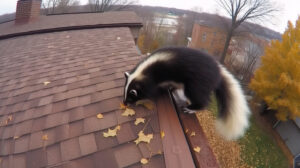You’ve probably woken up to the distinctive odor of a skunk wafting through your window. While unpleasant to you, it’s even more unpleasant to whatever — or whoever — was on the receiving end of this smelly spray. But your neighborhood skunk isn’t spraying just for fun: skunks use their foul-smelling odor to protect themselves.
Why Do Skunks Spray?
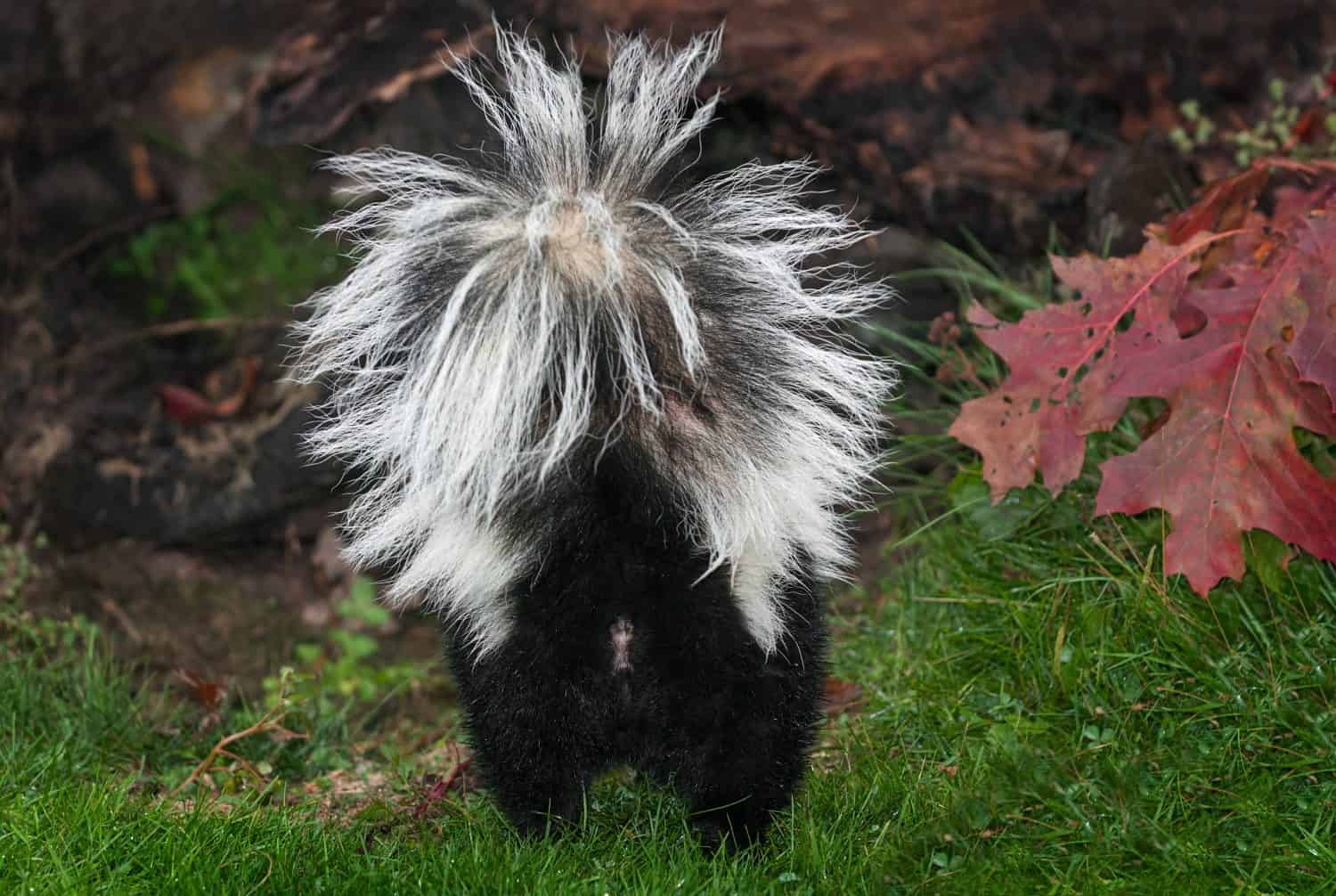
A skunk’s spray can be smelled up to half a mile away.
©Holly Kuchera/Shutterstock.com
Skunks use their scent to protect themselves. Skunks are slow, lumbering animals with claws designed for digging, not protection. This means that their only true defense mechanism is their awful emissions. The source of the skunk’s smell is in its anal glands. These glands produce strong-smelling oily fluid. In skunks, the anal glands extend out of their anus so that they can release the oil outside of their bodies. They are one of the few animals that can direct the spray of their anal-gland oils and can shoot up to 15 feet. There are 12 species of skunks, and all of them have this ability.
However, they don’t spray for just any reason. Skunks produce approximately four tablespoons of oil at one time. After this is depleted, it can take seven to 10 days for their anal glands to regenerate the liquid. During this time, the skunk is effectively defenseless. Skunks are born with musk glands and can spray as early as seven days old. However, they can’t spray with accuracy until they are around four months old.
Almost all animals know to avoid the skunk, or risk being sprayed. As a result, few animals prey on skunks unless they are particularly desperate (or ignorant, like a domestic dog). Great-horned owls are one of the few species that regularly feed on skunks. This is because the owls have an underdeveloped sense of smell, so they can’t detect the odor the skunk puts out.
Skunks Aren’t the Only Smelly Ones
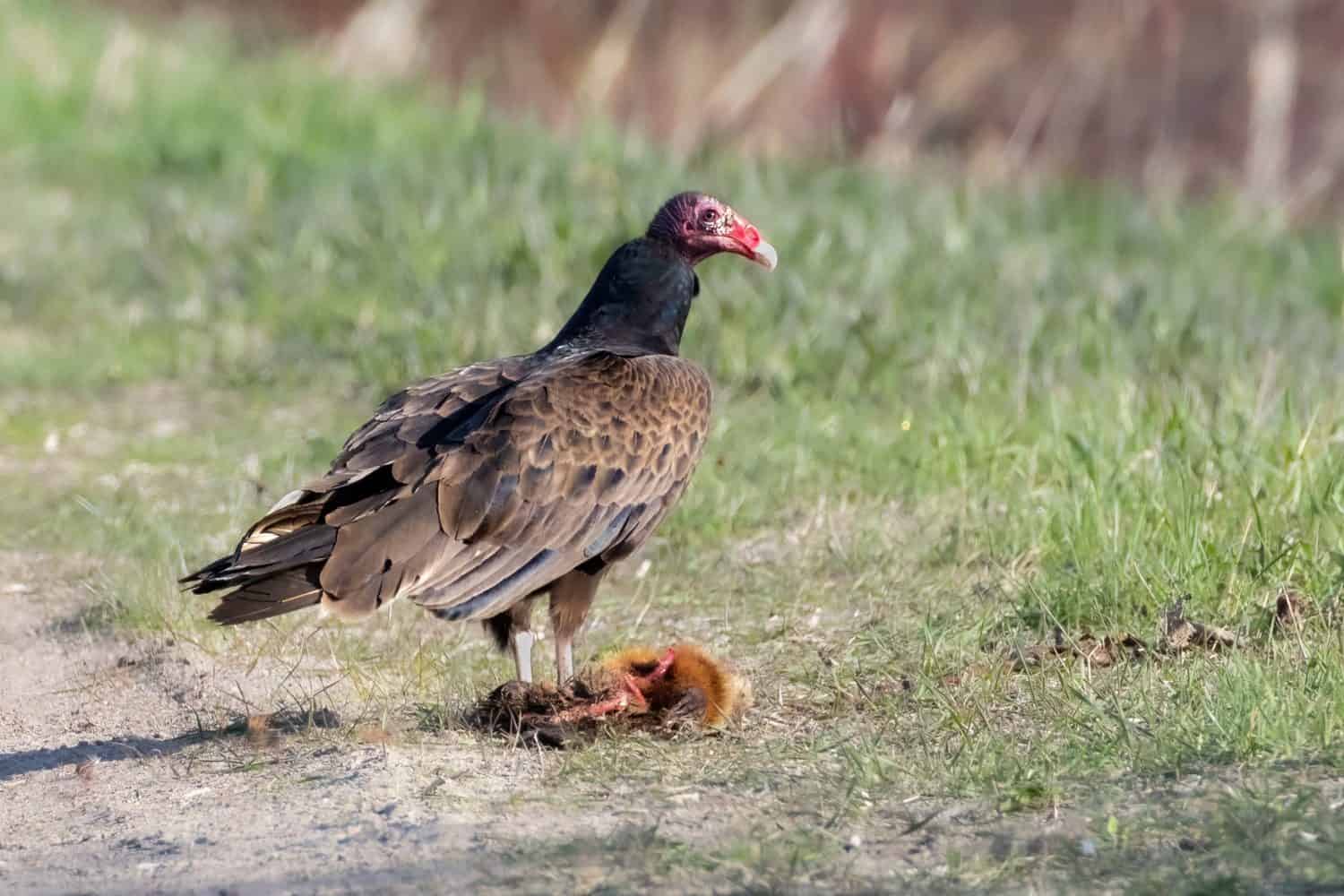
When threatened, vultures can projectile vomit smelly, partially digested food up to 10 feet.
©Jean Landry/Shutterstock.com
While skunks are well-known for their odorous emissions, other animals use smell as a defense mechanism. Although most other animals cannot direct their spray like a skunk can (skunks can spray accurately within feet of their target) scent is a popular way to deter predators.
Animals also use smell to mark territory, attract mates, and even fool predators. If a Virginia opossum is threatened, it will play dead and emit a foul-smelling green liquid from its anus, in an attempt to convince predators that it is spoiled and inedible. Domestic cats mark furniture with their potent urine to claim territory. Male lemurs produce a fruity-smelling scent on their wrists to attract potential mates during breeding season. When vultures are threatened, they vomit incredibly foul-smelling stomach acid and partially digested food. Considering vultures eat carrion, the resulting vomit can be extremely odorific!
Scent has many uses in the animal kingdom, but defense is a big one. But what animals besides skunks take advantage of this odorous weapon?
1. Stink Badger
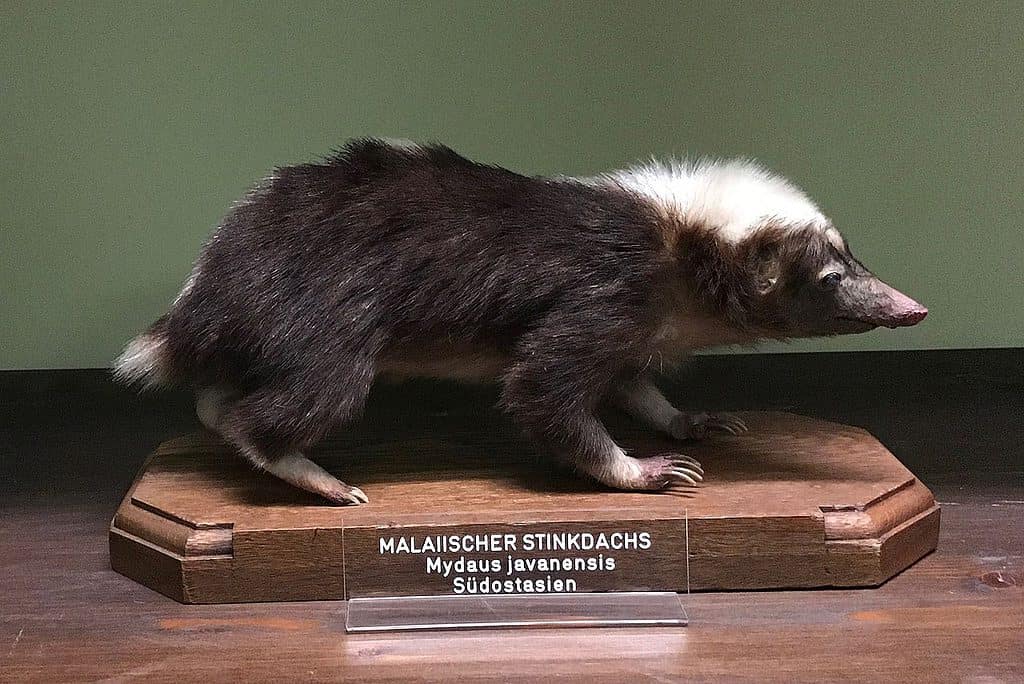
Stink badgers are listed as vulnerable by the IUCN.
©U.Name.Me / CC BY-SA 4.0 – License
The stink badger is aptly named. Stink badgers (also known as false badgers) look like badgers and secrete a foul-smelling liquid for defense. While this animal resembles the badger, it is a member of the skunk’s Mephitidae family.
There are two species of stink badger: The Palawan and the Sunda stink badger. Like their skunk relative, stink badgers can spray liquid from their anal glands. They can shoot the foul-smelling yellow oils up to 3 feet. Also, like skunks, this is their primary form of defense.
2. Green Wood Hoopoe

Wood hoopoes are native to
Africa
.
©bpperry/iStock via Getty Images
The green woodhoopoe may look small and defenseless, but it has a trick up its sleeve (or feathers). When threatened, the hoopoe releases an odorous fluid (that smells like rotting meat) from a gland above its tail. Chicks can also produce streams of excrement that can spray up to 20 inches. This helps them protect themselves if the mother is away from the nest.
3. Striped Polecat

Polecats are also called “zorillas” from the Spanish word that means skunk.
©Michal Sloviak/Shutterstock.com
The striped polecat is often confused with a skunk due to its distinctive black and white stripes. However, polecats are members of the Mustelidae family, not Mephitidae, and are related to weasels, stoats, badgers, and otters. All the mustelids have anal glands that produce noxious secretions.
Polecats are territorial animals and use their anal glands to help mark their territories. They also use their spray as a defense mechanism and have even been seen scaring off lions with the threat of spraying. Their incredibly smelly spray can temporarily blind predators and cause burning sensations in the mucous membranes and eyes.
4. Millipede
When a millipede is threatened, it will often curl up motionless. It will then secrete a smelly cyanide-like chemical from glands called ozopores on their sides. In addition to smelling bad, the secretions also taste disgusting. Since millipedes can’t bite or sting, these chemicals (including hydrochloric acid, hydrogen cyanide, and other caustic compounds) are the millipede’s primary defense mechanism. In addition to the bad odor, side effects of exposure to the chemicals include skin irritation or discoloration.
5. Weasel
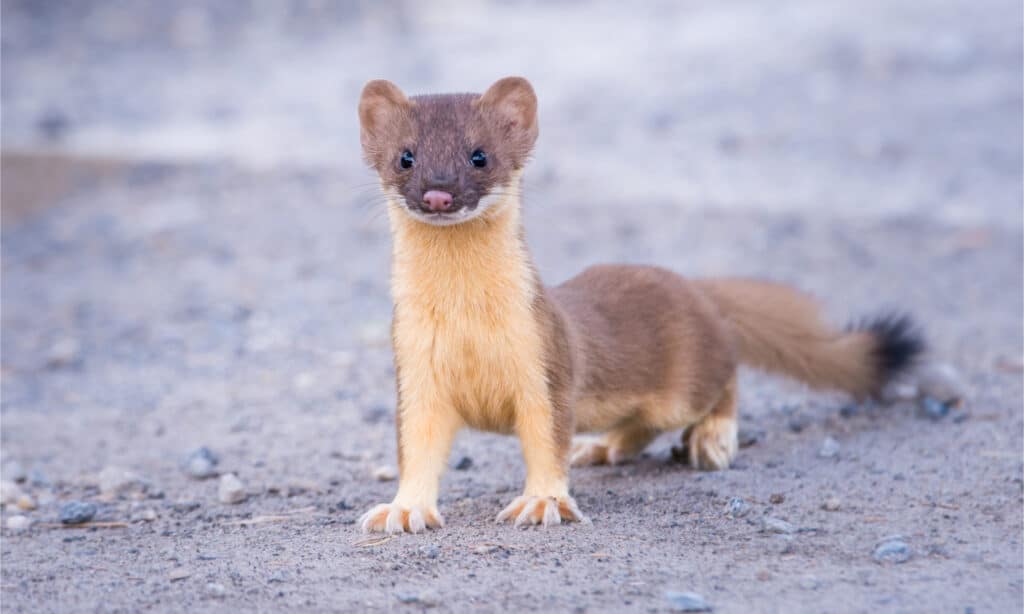
Weasels may look cute, but there’s nothing endearing about their smell.
©Ghost Bear/Shutterstock.com
Another Mustelid, the weasel also uses foul-smelling anal gland secretions to deter predators. They can shoot up to two tablespoons of the thick, yellow, oily spray at a time. Unlike the skunk, the weasel cannot control the direction of its spray. Weasels generally have a distinctive, musky odor even when they are not releasing spray. They also use their scent to mark their territories.
6. Bombardier Beetle
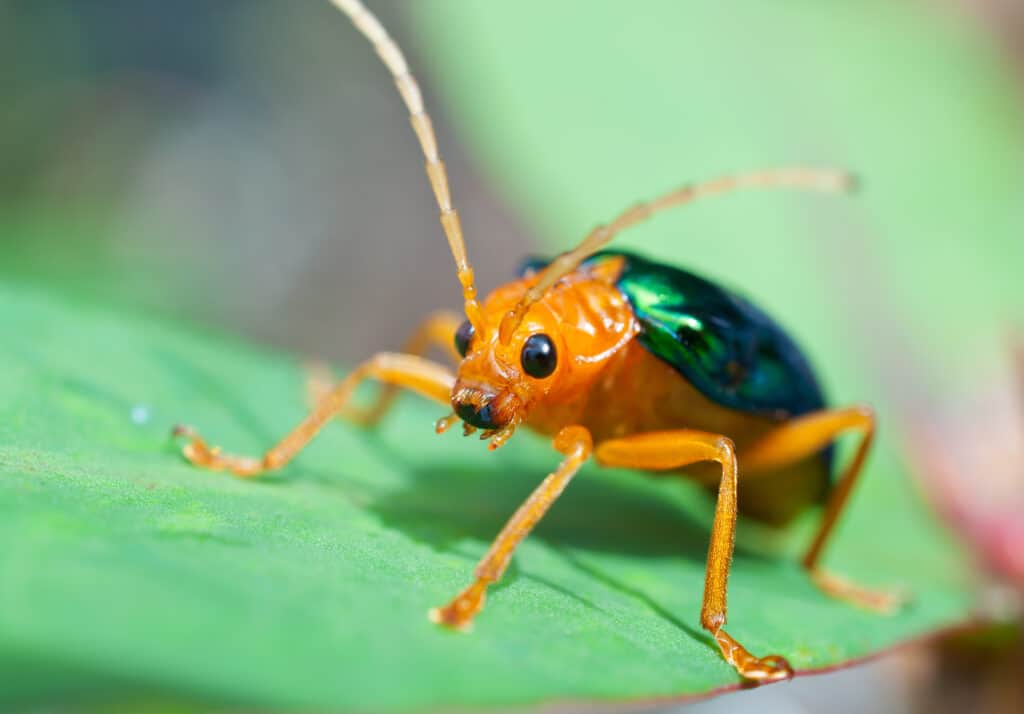
Bombardier beetles fall into different tribes including Brachinini, Pausini, Ozaenini, and Metriini.
©johannviloria/Shutterstock.com
More than 500 species compose this faction of ground beetles that can spray hot, noxious chemicals from their abdomens when threatened. Talk about dropping a hot bomb on your enemies: their spray can be heated up to 212 degrees Fahrenheit. When threatened, chemicals are mixed with enzymes in a chamber, heating the caustic fluid that can be expelled at up to 22 miles per hour. These secretions are irritating to the respiratory system and the eyes of predators.
The photo featured at the top of this post is © Geoffrey Kuchera/Shutterstock.com
Thank you for reading! Have some feedback for us? Contact the AZ Animals editorial team.




